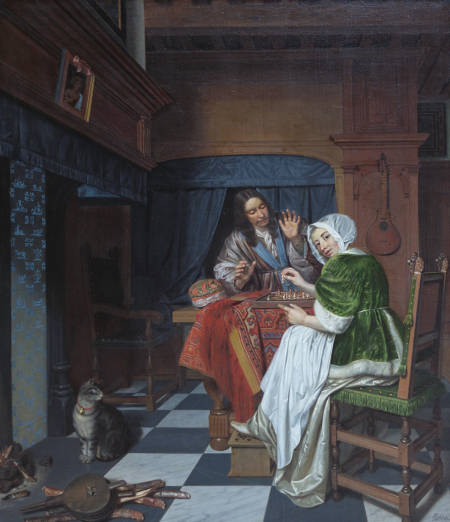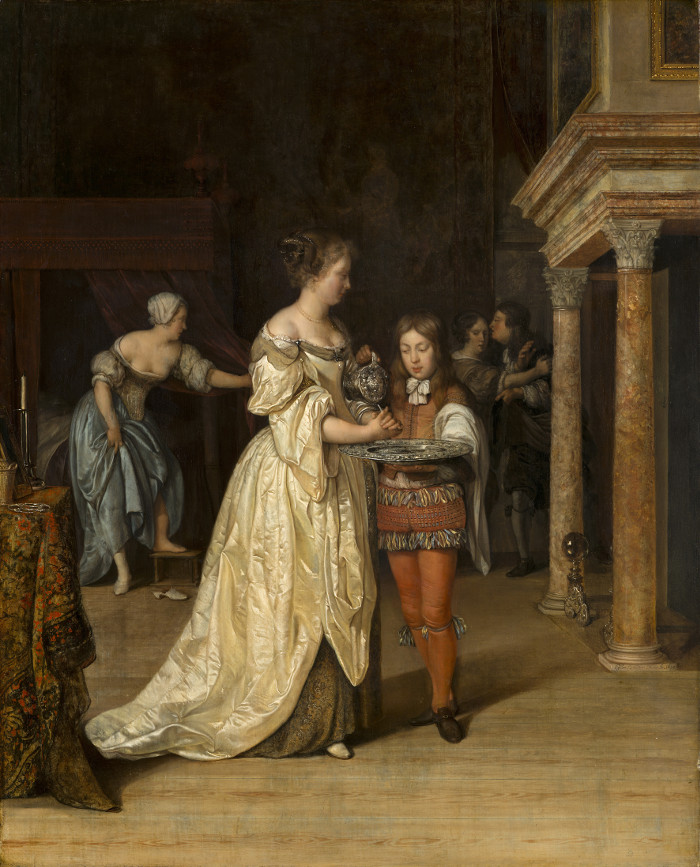Young Woman with a Water Pitcher
c. 1662–1665Oil on canvas
45.7 x 40.6 cm. (18 x 16 in.)
Metropolitan Museum of Art, New York
With a few exceptions—The Music Lesson being the most obvious Vermeer—in the early 1660s moved away from the type of interior that he, De Hooch, and other painters (such as Ludolf de Jongh in Rotterdam) had painted in the period about 1657–1656, and adopted an approach that in some respects was closer to that of the Leiden artists Metsu and Frans van Mieris. The preoccupation with linear perspective and geometric order diminished in favor of simpler compositions, in which the view is usually brought in closer, only one figure is depicted, and the behavior of light becomes the dominant aesthetic concern.
The description of light on surfaces such as fine materials, metal, and glass had already engaged Vermeer in The Letter Reader, The Milkmaid, and other paintings of about 1657–1658, partly in response to Leiden artists. De Hooch's style of the late 1650s offered a different model in that space and light are more broadly rendered, and details are textures generalized. A similar approach is found in the oeuvres of Carel Fabritius and Emanuel de Witte, and from the beginning Vermeer was also predisposed to an optical rather than a tactile manner. His style of the 1660s is a distinctive synthesis of qualities absorbed from various sources in a highly selective way. Light, broad areas of shadow, and pregnant spaces reveal close observation and a survey of current artistic alternatives. Qualities that might have been admired in the same sources—for example, the precise drawing that commonly accompanies an enthusiasm for artificial perspective (as in De Man's work) (fig. 1) and the dwelling upon surface incident for which Gerard Dou was known—were passed over by Vermeer. Pieter Teding van Berkhout's appreciation of perspective in Vermeer, expressed in 1669 would have been appropriate for paintings like The Glass of Wine and The Music Lesson, but the "most curious aspect" of the artist's work after the early 1660s was his consistent description of forms and space in terms of light and color values despite the importance of perspective in his work.

Cornelis de Man
c. 1670
Oil on canvas, 97.5 x 97.5 cm.
Museum of Fine Arts, Budapest
These considerations bear upon the placement of the Marquand canvas (Young Woman with a Water Pitcher) in Vermeer's oeuvre. Recently it was dated to about 1664–1665 and interpreted as a mature instance of "Neo-platonic" composition, something of which no other Dutch artist has been accused. Lawrence Gowing more plausibly suggested a date of about 1661–1662 and with a surprising but incisive choice of words described the painting as "the most primitive of its type," which he finds in more mature form in Woman in Blue Reading a Letter and other works that he dates to about 1662–1664 and groups together as "pearl pictures" (in honor of Woman with a Pearl Necklace).
The painting's wonderful sense of order and harmony was achieved by restricting the color scheme mostly to whites and values of the three primaries, by framing the conical figure with rectangular shapes, and by suspending animation through an intense study of light effects. In general terms, the design is a reduction of the De Hooch-like compositions found in the paintings in Berlin, Brunswick, and the Frick Collection, where in each case a standing man hovers over a seated woman; the figures and furniture form pyramids in a Cartesian realm. The admirable but rather deliberate dovetailing of motifs (in The Glass of Wine for example, the bench is slotted between the wall and table like a strip of marquetr, continues in the present picture: the woman's left arm extends the contours of the pitcher; the map's wood bar tucks into the angle of her shoulder and head (the map originally extended much farther to the left, so that the head was framed in a corner); and the "negative" shapes within and around the contours of the figure are all given their proper visual weight (which required removing a chair from the corner). The pose of the figure and placement of the table have a noble ancestry descending from Van Miereveld's state portraits to Rembrandt's Aristotle with a Bust of Homer (the cavalier contemplating a young woman in The Glass of Wine has some affinity with Rembrandt's philosopher). Of course, Vermeer did not derive ideas from these sources but simply shared with them a high regard for the classical tradition.
The painting's design exquisitely suits its subject, which is an idealized view of feminine beauty and virtue. Dou painted pictures of old women, their heads less elegantly covered, watering plants outside of windows (fig. 2), and also pictures of an attractive young woman opening a window or pushing a curtain aside. Vermeer may have conflated two such images or derived his version from a Leiden model now unknown. That the artist avoids conventional narrative has been stressed by recent writers. However, a contemporary viewer would have recognized the head and shoulder coverings, the silver-gilt basin and pitcher (with which one would not normally water plants), and the jewelry box as the accouterments of a well-to-do city woman's toilette. That she opens or looks out the window does not disturb, indeed enhances, the sense of unself-conscious activity. Vermeer represents but a moment of private life, and a patrician ideal.

Gerrit Dou
c. 1660–1665
28.3 x 22.8 cm.
Kunsthistorisches Museum, Gemäldegalerie, Vienna
The Map of the Netherlands
This tranquil scene, notable for the simplicity of the forms which define the composition and the relationship between the different shades of red, blue and ochre, presents an idealized vision of feminine virtue and is an excellent example of Vermeer's exquisite sensitivity in the observation of reality.
Johannes Vermeer
c. 1662–1665
Oil on canvas, 45.7 x 40.6 cm.
Metropolitan Museum of Art, New York
From the beginning of the 1660s when this work was produced, Vermeer's interiors became simpler, and focused less on the construction of the perspective and more on the representation of light, possibly under the influence of Leiden artists such as Metsu and Van Mieris. In contrast to these artists and to his own earlier work, in the 1660s Vermeer painted scenes which do not appear to depict any specific event or activity nor do they offer dues as to what has just happened or is about to happen.
Both the woman's clothing and the Persian carpet on the table as well as the other carefully arranged objects in the scene identify her as a member of the upper classes, depicted here in a moment of repose. Vermeer's mastery lies in the way he makes the formal structure of the work correspond to the serenity of the subject matter, allowing the spectator to discover the harmony and beauty beneath the chance events of everyday existence. To achieve this, the details are extremely important, such as the cadence created by the lines of the woman's arms and her amiable expression (fig. 3) which contribute to the warmth and sensation of restraint which the scene conveys. The artist's care in the design of the composition led him to make changes as he worked on it beneath her right elbow are traces of a chair, which Vermeer subsequently decided to move back to the wall behind the table. We also know that the map of the seventeen provinces of the Netherlands (fig. 4) initially hung closer to the window.

Huyck Allart (active c. 1650–1670)
1671
The light is another key element in this work. With great subtlety Vermeer represents the way the light that bathes the scene falls on the metallic objects or the interior frame of the window, while the luminosity of the end wall gives unity to the composition.
The poetry of Vermeer's vision is nowhere better seen than in Young Woman with a Water Pitcher. As though transfixed in a moment of time, a young woman stares absently toward the window, resting her right hand on the frame and holding a water pitcher in the other. While her embracing pose welcomes the cool light filtering through the leaded panes of the open window, her expression imparts a sense of repose and inner peace. Vermeer reinforces this mood through the quiet, restrained framework of geometric shapes surrounding her.
The serenity of this work is so all encompassing that it is hard to identify any recognizable narrative. Unlike the understandable, physical activity in Woman Washing Her Hands by Eglon van der Neer (1634–1703) (fig. 5), the central presence of the water pitcher in Vermeer's painting is not easily explained. If the woman prepares her morning toilet, why is there an open jewelry box with pearls, but no mirror, comb, or powder brush, objects generally associated with such an activity? Why has Vermeer depicted her with a wide, white linen collar covering her shoulders, an accessory probably related to the toilet but not otherwise found in his paintings? Finally, does the wall map of The Seventeen Provinces (fig. 4) that Vermeer included so prominently behind the woman relate to a narrative, particularly since he depicts only the portion representing the southern provinces?

Eglon van der Neer
1675
Oil on panel, 49.2 x 39.6 cm.
Mauritshuis, The Hague
Such questions, while appropriate to ask when considering some of Vermeer's works and most genre paintings by his contemporaries, seem irrelevant in the presence of a painting such as this. While Vermeer conceived Young Woman with a Water Pitcher within an accepted iconographic framework, he differed from other artists in that he avoided narrative as a means for communicating meaning. For example, Van der Neer used the motif of hand-washing both for its narrative potential and for its symbolic meaning. In Dutch emblematic traditions, cleansing symbolizes purity and innocence, as De Jongh has noted. The gesture of hand-washing in Van der Neer's painting thus symbolically differentiates one woman's moral character from that of another who emerges from the bed in the background. While the ideals of cleanliness and purity are also at the core of Vermeer's image, the artist expresses them in an entirely different way. As the woman stands poised between the window and the water pitcher, her actions seem suspended in time. Hers is a lasting, rather than fleeting, moment, one given further significance by Vermeer's pristine harmonies of light, color, and shape.
Vermeer's subtle compositional adjustments reveal the care with which he conceived his image. One of these adjustments, clearly visible with the naked eye, is a chair with lion-head finials that once occupied the left foreground. An infrared reflectogram demonstrates that Vermeer also altered the position of the wall map that originally hung directly behind the woman. In both instances Vermeer blocked in these initial compositional ideas with gray paints. With these changes, Vermeer created a dynamic tension within the painting. The energy encompassed by the woman's body and gaze is now skillfully counterbalanced by the concentration of objects on the right. Moreover, by removing the chair and changing the position of the map, Vermeer preserved the purity of the white wall between the woman and the window, thus a flowing light to flow directly onto her, uninterrupted by any visual interference.


